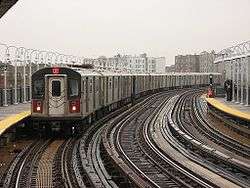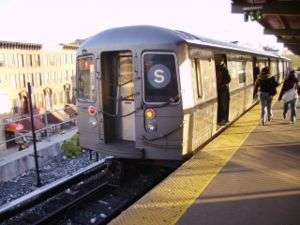R46 (New York City Subway car)
| R46 | |
|---|---|
|
An R46 train on the | |
|
Interior of an R46 car. | |
| In service | 1975-present |
| Manufacturer | Pullman Standard Rail Company |
| Built at | Chicago, Illinois |
| Replaced | All remaining R1-R9s some R10s, and all GE R16s |
| Constructed | 1975–1978 |
| Refurbishment | 1990–1992 |
| Number built | 754 |
| Number in service | 752 (580 in revenue service during rush hours) |
| Number scrapped | 2 |
| Formation | 4 car sets |
| Fleet numbers |
5482–6207, 6208–6258 (even) (originally 500–1227, 1228–1278 (even)) |
| Capacity |
70 (seated-A car) 76 (seated-B car) |
| Operator(s) | New York City Subway |
| Depot(s) |
Jamaica Yard (364 cars) Pitkin Yard (388 cars)[1] |
| Service(s) assigned |
|
| Specifications | |
| Car body construction | Stainless steel with fiberglass end bonnets |
| Train length |
4 car train: 300 feet (91 m) 8 car train: 600 feet (180 m) |
| Car length | 75 ft (22.86 m) |
| Width | 10 ft (3,048 mm) |
| Height | 12.08 ft (3,682 mm) |
| Platform height | 3.76 ft (1.15 m) |
| Entry | Small extension on the bottom edge of door. |
| Doors | 8 |
| Articulated sections | 1-2 in the advertisement frames on the inside ends of the car. |
| Maximum speed | 55 mph (89 km/h) |
| Weight |
91,000 lb (41,277 kg) (A car) 86,670 lb (39,313 kg) (B car) |
| Traction system | General Electric SCM 17KG192AH1 propulsion with GE 1257E1 motors |
| Power output | 115 hp (85.8 kW) per axle |
| Electric system(s) | 600 V DC Third rail |
| Current collection method | Contact shoe |
| Braking system(s) | New York Air Brake "SMEE" Braking System, Tread Brake unit model D7587719 |
| Safety system(s) | emergency brake |
| Headlight type | Halogen light bulb |
| Track gauge | 4 ft 8 1⁄2 in (1,435 mm) |
The R46 is a New York City Subway car model built from 1975 to 1978 by the Pullman Standard in Chicago, Illinois for the IND/BMT B Division. The cars replaced many R1-R9 series cars and all 1925 Standard Steel built SIRTOA ME-1 trains, providing Staten Island with a new fleet of railcars. They, along with the previous R44s, are 75 feet (22.86 m) long. The cars replaced all remaining R1-R9 series cars and all GE-powered R16s, which had many reliability issues.
Description

The R46s are numbered 5482-6207 and 6208-6258 (even numbers only). 5482-6207 were originally numbered 500-1227 (except numbers 941 & 1054, as those two cars were scrapped prior to overhaul), and 6208-6258 were originally numbered 1228-1278, even numbers only.
The R46 order consisted of 754 single cars, originally planned to be 745,[2] that were numbered from 500-1278. Even cars with cabs are A cars; odd cars without cabs are B cars. The first two trains of R46s were placed in service on the F and N on July 14, 1975, with a brief ceremony at the 34th Street – Herald Square station, attended by Mayor Abraham D. Beame and MTA Chairman David Yunich. It is infamous for having had frequent problems in the first decade of service. During the 1976 U.S. Bicentennial celebration, cars 680 and 681 had white, red and blue star bands on their bases and were respectively renumbered 1776 and 1976.[3]
Currently, the fleet is maintained at Pitkin Yard and Jamaica Yard, running on the A, F, R and Rockaway Park Shuttle.
History
Delivery and fleet problems
The earliest of issues with the R46 dated back to the time they were delivered, as a portion of the 754 car order was far behind schedule because there was a strike at the builder, Pullman Standard. Because of the strike and other problems, the final R46s entered service in December 1978, which was three years behind schedule.
Cracks and leaks
In March 1977, there was a crack found in the frame of one of the lightweight Rockwell trucks, which resulted in a motor breaking loose from the trucks transom arms, striking an axle. By 1978, cracks were found in 264 R46 trucks. Because of these problems, all R46s had to be checked three times per week for truck cracks. In February 1978, 889 cracks were found in 547 of the trucks. The cracking was such a bad problem, that on June 14, 1979, New York City Mayor Koch ordered R46s with trucks that had 2 or more cracks out of service. Then, more that 1,200 cracks had been found by that day and they were classified into seven types. There was an account that called the R46s "the most troubled cars ever purchased". By this time, the number of cracks had almost doubled, from 889 cracks found in February 1979 to 1,700 in March 1980. In order to keep track of the R46s structural issues, they were inspected several times a week. In September 1980, two types of cracks that were not seen before were found on the trucks. As a result, the NYCTA tried to minimize usage of the R46 fleet, until their trucks were replaced with new R44 type standard trucks ordered from General Steel and Buckeye Industries.
Brake flaws and other flaws
In July 1979, Pullman Standard informed the MTA that the hand brake assemblies for the R46 were problematic. In late July 1979, inspections revealed that the steel where the car body was joined to the truck was wearing away, a severe safety issue.
At the end of 1979, there were many other flaws found in the R46 fleet and the Transit Authority filed another US$80 million charge against Pullman Standard and a number of other subcontractors. This lawsuit invalidated an agreement made with Pullman by executive director John G. DeRoos for US$1.5 million in spare parts to remedy the defects.
1989-1992 overhaul

From 1989 to 1992, Morrison-Knudsen of Hornell, New York rebuilt 752 of the 754 original R46s through the GOH (General Overhaul) program. The other two (originally 1054 and 941) were heavily damaged when an E train hit the tunnel wall near 179 Street–Jamaica on April 26, 1986, prior to the GOH. This resulted from the motorman, Alick Williams of Saint Albans, having a heart attack, and he died at the scene. The two cars were scrapped on June 4, 1987.[4]
During the GOH, the fleet received the same LCD destination signs as the R44s, replacing the older rollsigns and the blue stripes on the side of the cars were removed, resulting in the appearance of an entirely unpainted carbody (the fiberglass ends remain painted silver to match the stainless sides). Other improvements included the rebuilding of all mechanical systems and making the R46 more compatible with other car types. The R46 cars were linked into sets following their general overhaul. 724 of the cars were linked in sets of four, 26 cars were linked up as A-A pairs and two cars were configured as one A-B married pair (6206-6207).[5]
After the R46s were rebuilt, they were renumbered 5482-6258 in the early 1990s. As a result of the overhaul, the fleet's reliability has vastly improved and it is no longer considered to be the lemon that it once was.
Recent work
The R46s are currently undergoing SMS (Scheduled Maintenance System). In 1981, the New York Transit Authority's car replacement program estimated that the R46s would be replaced in 2011.[6] However, the MTA now estimates the cars to remain in service until about 2022, when they will be replaced by the R211s.[7]
See also
- R44 (New York City Subway car) - a similar model built by St. Louis Car Company. This model currently only operates on the Staten Island Railway.
References
- ↑ New York Subway Barn Assignments – November 6, 2016
- ↑ "www.nycsubway.org". www.nycsubway.org.
- ↑ Cunningham, Joseph; DeHart, Leonard O. (1993-01-01). A History of the New York City Subway System. J. Schmidt, R. Giglio, and K. Lang.
- ↑ "www.nycsubway.org". www.nycsubway.org.
- ↑ "www.nycsubway.org". www.nycsubway.org.
- ↑ The New York Transit Authority in the 1980s.
- ↑ MTA CAPITAL PROGRAM MILESTONES - March 31, 2011
Further reading
- Sansone, Gene. Evolution of New York City subways: An illustrated history of New York City's transit cars, 1867-1997. New York Transit Museum Press, New York, 1997 ISBN 978-0-9637492-8-4
External links
| Wikimedia Commons has media related to R46 (New York City Subway car). |
- nycsubway.org - NYC Subway Cars: R46
- BMT-IND Car Assignments – November 6, 2016
- New York City Subway Car Fleet June 2010 through November 2016




